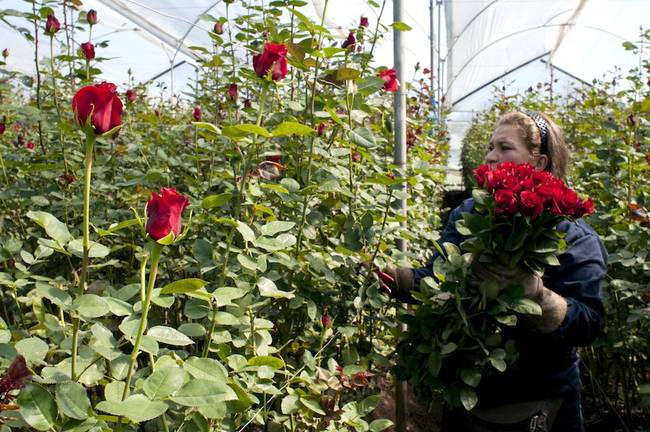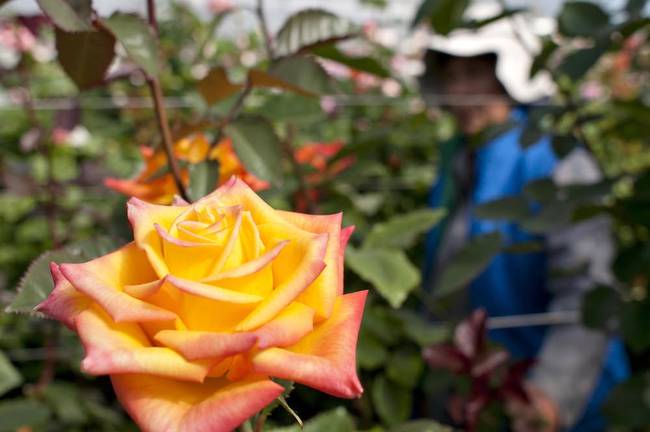By Brittany Wienke, Rainforest Alliance
Where do flowers come from? It’s kind of a funny question to ponder, because many of us don’t know. Of course, we all know that flowers are a part of a plant. We all know plants grow in the ground. We all know those gorgeous, long-stemmed roses you give your sweetheart on Valentine’s Day don’t grow in the florist’s shop. But we don’t think about their origin.
About 90% of all roses are grown on flower farms in South America, with Colombia and Ecuador in the lead, and many of the ferns surrounding those roses come from Costa Rica or Guatemala. In South and Central America, floriculture represents thousands of jobs, often for women, and is a thriving industry. In fact, Americans spend about $1.9 billion on Valentine’s Day flowers. Your lovely holiday bouquet contributes to an important source of income for thousands of people in the tropics.
But because flowers are not grown for food (at least, not usually), the floriculture industry is not as closely regulated by governments as other crops. Flower farmers tend to use liberal doses of toxic pesticides and other agrochemicals to boost plant productivity. In some instances, the governments of countries importing the flowers actually require extensive pesticide use to ensure flowers are free of pests when they arrive.
© Rainforest Alliance
This agrochemical use comes at a huge price to the farm workers, their families and communities, and local water systems. As agrochemicals circulate through the waterways, drinking water supplies can become contaminated, which in turn negatively affects the health of local communities. They can also impact the health of the vibrant aquatic and stream-side habitats, disrupting life cycles of the plants and animals that live in those ecosystems.
The soil on and near the farm also suffers. We’re only just beginning to understand the incredibly important role soil plays in terms of regulating climate and sequestering atmospheric carbon—not to mention the complicated symbiotic relationship between microorganisms in the soil and plants. But when agrochemicals are introduced into this delicate environment, the whole system is compromised.
It’s safe to say traditional flower agriculture may not be the best of ways to grow a rose. Thankfully, there is an alternative.
Over the course of four years, we at the Rainforest Alliance worked with the Sustainable Agriculture Network to develop strict sustainability requirements for farms. Farms that adhere to these requirements actively protect worker health, minimize agrochemical use, and work to keep soil and waterways clean.
At Ipanema Farms in Colombia, for example, you can see the beneficial effects of using these sustainable practices from your first step onto the farm. Just outside the rows of multicolored roses, you can see the rich, biodiverse reservoirs the farm established to provide habitat for wildlife. These fish serve as water quality indicators—the moment the fish start dying, farm managers know something is wrong and can work toward solving the problem. Also found on the farm is the rare tingua bird, considered endangered by the IUCN—and another sign of booming biodiversity.
Ipanema Farms employs more than 3,000 people—and around Valentine’s Day, that number swells to almost 4,500. Each employee has access to medical care, a critical criteria of the sustainability standards. Workers can also bring their young children with them, knowing that they’ll be looked after at the daycare and school center on the farm’s premises.
 © Rainforest Alliance
© Rainforest Alliance
Because the farm adheres to the sustainability requirements, pesticides are used only when absolutely necessary, when all other forms of pest control have been tried. This keeps a huge amount of dangerous chemicals out of the water system, soil, and away from farm workers. And ultimately, it produces a healthier, higher-quality product—a rose that comes from a hardy, resilient plant. For Valentine’s Day, Ipanema Farms exports 30 million roses to the United States.
Ipanema Farms is not an isolated example. Sustainable floriculture is happening all over the tropics, from Costa Rica to Ecuador to Kenya—and at all different scales, too. At Flores y Plantas Ornementales in Costa Rica, another certified farm, nearly 4,500 tons of tropical flowers are exported each year. In Kenya, certified flowers from smallholder famers move up the value chain to major retailers in Europe. Currently, about 2,800 acres of flower farms worldwide are using these sustainable practices. That’s about 78 billion flowers.
These farms’ sustainable agriculture practices go beyond worker health, soil and water health, and protecting biodiversity, though those are all very important. By keeping natural systems in balance, giving and taking from the land in a symbiotic fashion and by producing a high-quality product, these farms increase their long-term business viability. This ensures a good working environment and quality of life for their employees—and their employees’ families.
 © Rainforest Alliance
© Rainforest Alliance
So when you give your Valentine a certified bouquet, consider the fact that those flowers are also supporting families, sustainable agriculture practices, and wildlife.










